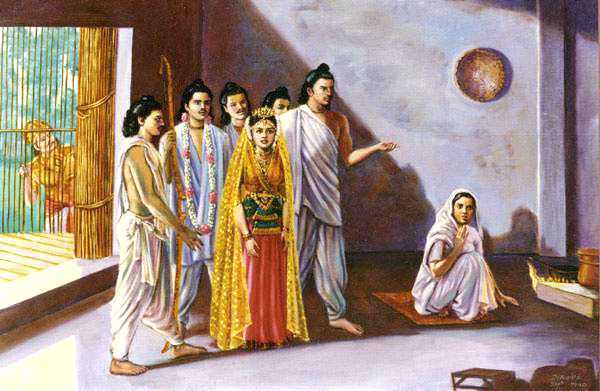The Mahabharata, one of the greatest Indian epics, is a treasure trove of extraordinary stories and characters. Among its many unforgettable figures, Queen Satyavati, the grandmother of the Pandavas, holds a significant place. Her biography is a captivating tale of love, sacrifice, and resilience that shaped the destiny of the Kuru king dynasty. Often overlooked in favor of her illustrious grandsons and the epic’s central heroes, Satyavati’s story is equally riveting.

In this article, we will delve into Grandmother of Pandavas Biography, including her life and family, uncover the profound impact and personal information. She had on the Indian epic Mahabharata and the lives of her descendants.
Grandmother of Pandavas Biography
The biography of Satyavati, also known as the “grandmother of the Pandavas,” begins with her humble origins. She was born in Tamil Nadu to Dasharaja, a chieftain of fishermen. As a young girl, she was nicknamed “Matsyagandha” for the fishy odor that accompanied her. Yet, her beauty and charm set her apart from others, even in her modest beginnings.
Satyavati’s transformation from a fisherwoman into the queen of Hastinapur and matriarch of the Kuru dynasty is one of destiny’s grandest narratives.
Read Also: What You Must Know About Nawaf Salam Biography
Satyavati’s Early Life: From Matsyagandha to a Queen
Born into a family of fishermen, Satyavati ferried passengers across the river as part of her daily life. Her life changed forever when she encountered Sage Parashara, one of the great sage of ancient India.
Captivated by her beauty, Sage Parashara blessed her with a divine fragrance and perpetual virginity after granting her a son. This son, Ved Vyasa (also referred to as Sage Vyasa or Veda Vyasa), later became the composer of the Mahabharata and an instrumental figure in shaping the Kuru lineage.
The Union with King Shantanu
Satyavati’s rise to royalty began when she met King Shantanu, the ruler of Hastinapur. The king was drawn to her celestial fragrance and proposed marriage. However, her father, the chieftain, imposed a condition: Satyavati’s children would inherit the Hastinapur throne.
This stipulation troubled King Shantanu, as his eldest son, Devavrata, was already the heir to the throne. To resolve this, Devavrata took a solemn vow of celibacy and renounced his claim to the throne. This monumental sacrifice earned him the name Bhishma, one of the greatest warriors and pivotal figures of the Mahabharata.
Satyavati as a Queen and Matriarch
As the queen of King Shantanu, Satyavati gave birth to two sons, Chitrangada and Vichitravirya. Both, however, met untimely deaths without producing heirs. To preserve the lineage of the Kuru clan, Satyavati called upon her firstborn son, Vyasa. Through the ancient practice of Niyoga, Vyasa fathered three sons:
- Dhritarashtra, the father of the Kaurava brothers.
- Pandu, the father of the Pandavas, including Arjuna, who heard the Bhagavad Gita from Lord Krishna.
- Vidura, known for his wisdom and unwavering commitment to dharma.
This pivotal decision ensured the continuation of the Kuru dynasty and set the stage for the events of the Kurukshetra war.
Satyavati’s Influence on the Mahabharata
Satyavati’s role extended far beyond her duties as a mother and queen. Her decisions significantly influenced the political and familial dynamics of the Mahabharata. The actions of her descendants, including King Pandu, Kunti, and the Pandava brother, were deeply rooted in the legacy she built.
Her influence can be seen in her efforts to maintain the Kuru lineage during tumultuous times. This dedication, combined with the wisdom of Vyasa and the strength of figures like Bhishma, defined the trajectory of the epic.
Lessons from Satyavati’s Life
Satyavati’s life story holds timeless lessons:
- Resilience in Adversity: Her transformation from Matsyagandha to a powerful queen exemplifies inner strength.
- Duty Above All: Satyavati’s commitment to preserving the Hastinapur throne and the Kuru dynasty came before her personal happiness.
- Sacrifice for the Greater Good: Like Bhishma, Satyavati made difficult choices to ensure the dynasty’s survival.
The Grandmother of the Pandavas and the Kurukshetra War
As the grandmother of the Pandavas, Satyavati’s decisions reverberated through history. Her choices led to the birth of Pandu, whose sons—Yudhishthira, Bhima, Arjuna, Nakula, and Sahadeva—would go on to fight the Kurukshetra war against their cousins, the Kaurava brothers.
Her influence extended to Kunti, Pandu’s wife, who raised her sons with unwavering devotion. With the guidance of Lord Krishna, the Pandavas eventually emerged victorious in the war, restoring dharma in ancient India.
Satyavati’s Legacy in Hindu Mythology
Satyavati’s life is prominently detailed in the Mahabharata and other ancient texts like the Devi Bhagavata Purana. Her role as a matriarch is symbolic of the power and influence women held in shaping the narratives of ancient India.
The legacy of the beautiful Satyavati lies not just in her actions but in her ability to adapt, lead, and make difficult decisions. She is an enduring figure of strength in Hindu mythology, whose story is still celebrated in regions like Tamil Nadu and beyond.
Conclusion
The biography of Queen Satyavati, the grandmother of the Pandavas, is an integral part of the Mahabharata’s intricate tapestry. Her life reflects themes of destiny, sacrifice, and resilience. From her humble beginnings to her monumental influence on the Hastinapur throne, Satyavati exemplifies the strength and wisdom required to shape an epic dynasty.
Her story reminds us that even in the face of adversity, leadership and determination can leave an indelible mark on history. As we revisit her tale, we not only honor her legacy but also draw inspiration from her extraordinary journey in ancient India.